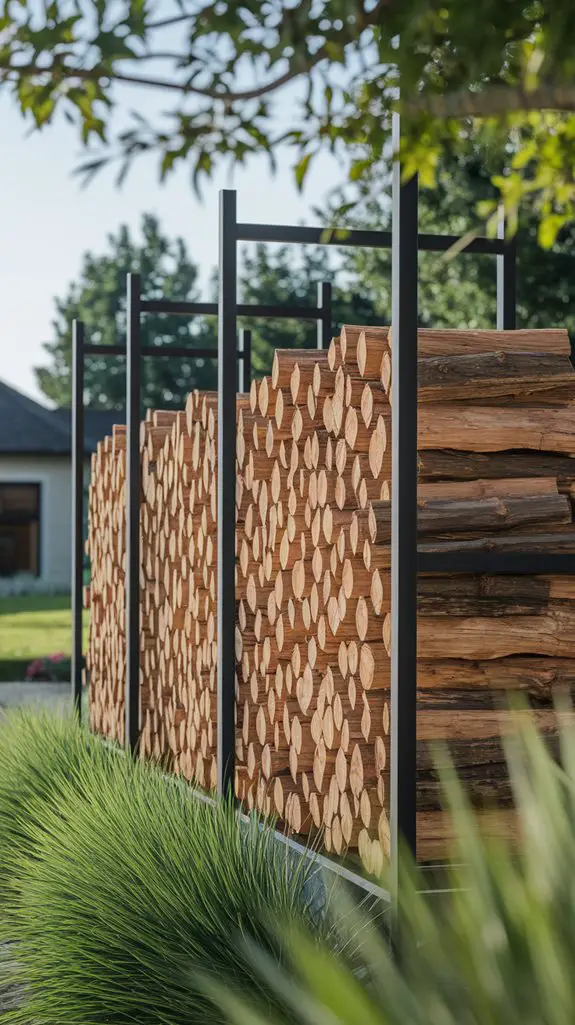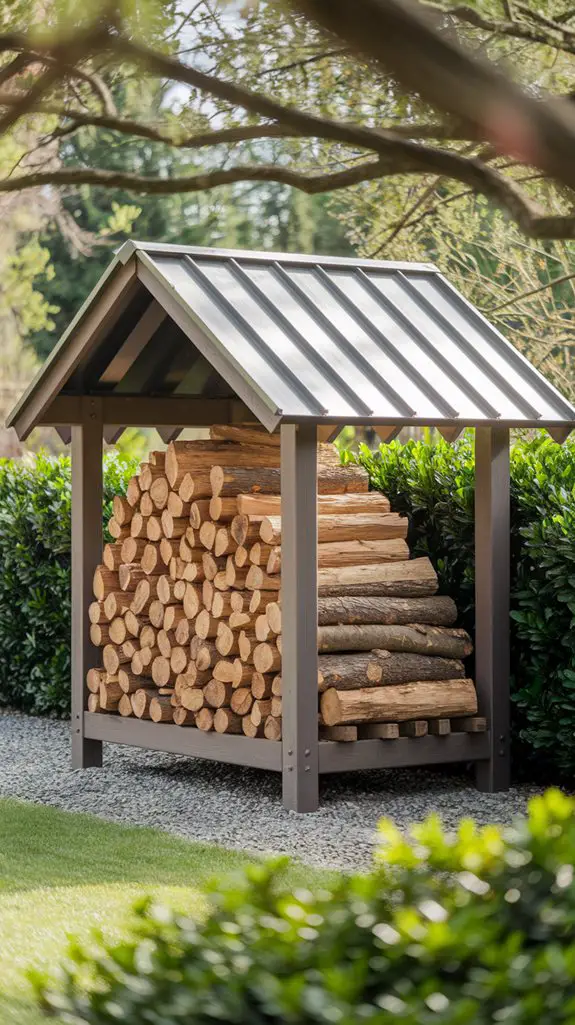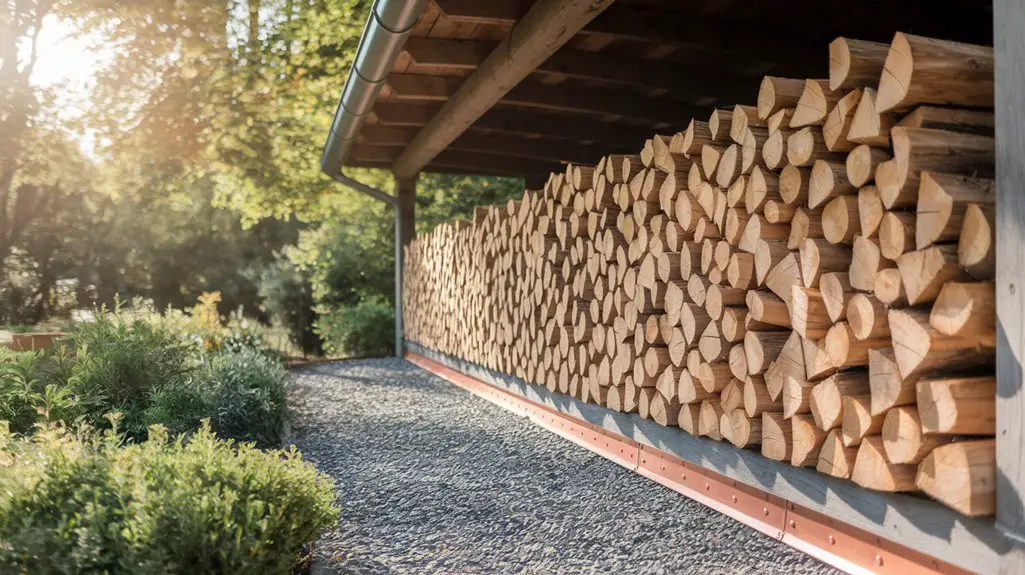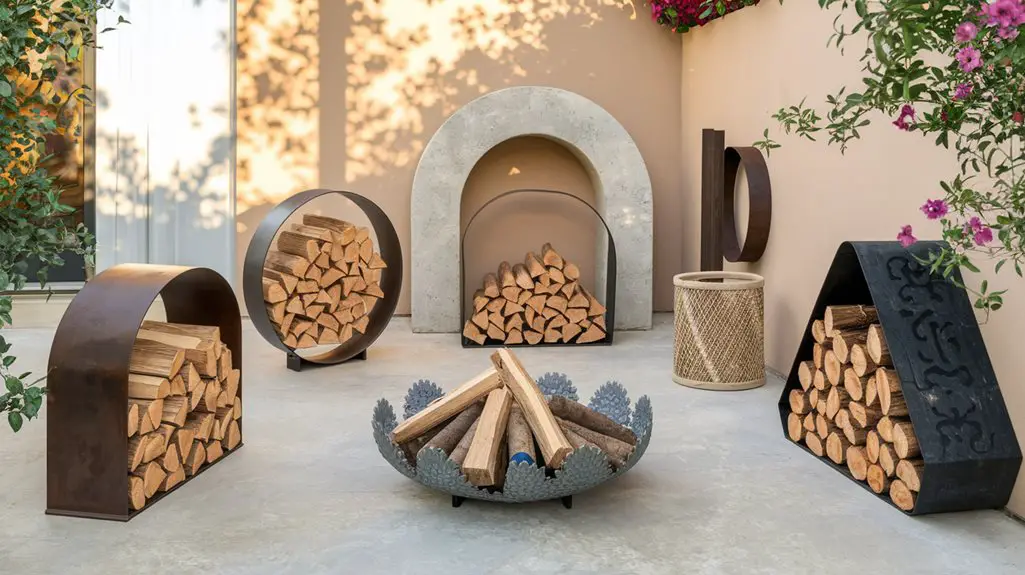You’ve invested time and money in quality firewood, but without proper storage, it’ll become a haven for unwanted guests. From termites to carpenter ants, pests can quickly colonize improperly stored wood and eventually migrate into your home. The consequences extend beyond simple annoyance—these invaders can damage structural elements and contaminate living spaces. Implementing strategic storage practices now will protect both your fuel supply and your property.
Elevate Your Firewood Storage Off the Ground
Elevating your firewood storage at least 6-8 inches off the ground creates a critical barrier against moisture infiltration and pest infestation. This elevation prevents direct contact with soil-dwelling organisms like termites, carpenter ants, and wood-boring beetles that typically access wood from below.
Implement this protective measure using concrete blocks, pallets, or specialized firewood racks with sufficient clearance. The elevation facilitates air circulation beneath the woodpile, accelerating drying and maintaining lower moisture content—conditions inhospitable to fungi and insects. Additionally, proper firewood storage methods can significantly reduce the risk of pest problems over time.
For ideal results, position the structure on a level, well-draining surface away from buildings. This configuration disrupts the capillary action that draws ground moisture upward through wood fibers, considerably reducing decomposition rates and extending your firewood’s usable lifespan.
Keep Firewood Away From Your Home’s Exterior

While proper elevation provides baseline protection, maintaining an adequate buffer zone of at least 30 feet between your firewood storage and home’s exterior constitutes a critical secondary defense against pest migration.
This distance effectively interrupts the transit corridors that termites, carpenter ants, and wood-boring beetles require to establish infestations. Species like Reticulitermes flavipes (Eastern subterranean termite) typically forage within a 100-foot radius, making proximity reduction essential.
You’ll also minimize the risk of cryptic wood roaches and dermestid beetles seeking warmth inside your dwelling during temperature fluctuations.
For operational efficiency, position your woodpile perpendicular to prevailing winds, allowing consistent airflow while maintaining the protective distance parameter.
This strategic placement optimizes wood seasoning while maintaining the critical spatial buffer that prevents pest colonization pathways. Additionally, consider using effective DIY traps to further deter pests from approaching your firewood storage.
Use a Covered Rack or Shelter for Weather Protection

Strategic coverage of your firewood supply represents the next defense layer in your integrated pest management strategy.
Implement a purpose-built rack with a waterproof cover that extends 3-4 inches over the woodpile’s edges but doesn’t reach the ground. This configuration prevents water saturation while maintaining essential airflow.
Select materials wisely—metal racks resist insect infestations compared to wooden alternatives. For ideal protection, consider a three-sided shelter with an angled roof pitch of at least 15° to facilitate water runoff.
Position the open side away from prevailing winds to minimize moisture exposure.
Install a 2-3 inch gravel base beneath your rack to enhance drainage and create an inhospitable environment for ground-dwelling pests.
This elevated, covered storage system considerably reduces moisture content—the primary attractant for wood-boring insects and fungal colonization. Additionally, using a weather-resistant firewood storage solution can further protect your firewood from the elements throughout the seasons.
Proper Seasoning: The First Defense Against Pests
Properly seasoning firewood serves as your primary defense mechanism against pest infestations before storage even begins. The process reduces moisture content to below 20%, creating an environment inhospitable to many wood-boring insects and fungi.
- Cut and split logs immediately after felling to accelerate moisture evaporation through increased surface area.
- Stack wood in single rows with adequate spacing between pieces to facilitate air circulation.
- Elevate stacks 6-8 inches off the ground using pallets or pressure-treated lumber.
- Position stacks in sunny, well-ventilated locations to enhance drying conditions.
- Allow minimum 6-month seasoning period (12+ months ideal for hardwoods).
Monitor moisture levels using a wood moisture meter to confirm proper seasoning.
Adequately seasoned wood produces a hollow sound when pieces are knocked together—a practical field test when instruments aren’t available.
Strategic Wood Pile Rotation for Minimal Pest Impact
Even with proper seasoning, implementing a methodical wood pile rotation system guarantees you’ll minimize cumulative pest impact over time.
Adopt a first-in, first-out (FIFO) protocol where you consistently use older wood first, preventing established insect colonies from proliferating.
Position your newest wood at the back of your storage area, gradually moving it forward as you consume the front-facing, older stock. This systematic rotation disrupts pest life cycles before they can complete multiple generations.
For best results, fully deplete one stack before beginning another.
Mark your wood with acquisition dates using chalk or a simple tagging system. During warmer months when pest activity accelerates, increase rotation frequency.
This temporal management strategy guarantees no single section of your woodpile becomes a permanent habitat for destructive organisms. Additionally, maintaining a pest-free backyard is crucial for overall outdoor enjoyment and health.
Natural Pest Deterrents for Your Firewood Stack
While chemical treatments offer quick solutions, natural alternatives provide environmentally sustainable methods for deterring wood-boring insects and other pests from colonizing your firewood supply.
Implementing these biological deterrents creates protective barriers without introducing toxins into your home environment.
- Cedar chips scattered throughout your woodpile release thujone, a natural repellent effective against beetles and termites.
- Diatomaceous earth applied around the base disrupts insect exoskeletons through microscopic abrasion.
- Essential oils (eucalyptus, tea tree, neem) sprayed on external logs create olfactory barriers.
- Beneficial nematodes introduced to surrounding soil target larvae stages of wood-boring insects.
- Strategic companion plantings of mint, lavender, or rosemary near storage areas repel numerous arthropod species.
Additionally, incorporating natural herbs such as basil and sage can further enhance the pest-repelling effects around your firewood storage.
These deterrents work synergistically with proper storage practices, enhancing protection through multiple defensive mechanisms.
Choosing the Ideal Location for Your Firewood Storage
The selection of an appropriate location for firewood storage greatly impacts both the quality of the wood and its resistance to pest infestation. Position your stack on elevated, well-drained ground to prevent moisture absorption from soil contact. Maintain a minimum distance of 20 feet from your dwelling to reduce the risk of pest migration into your home.
Ensure adequate airflow by selecting a location with consistent cross-ventilation. Southern exposures maximize sunlight exposure, facilitating natural drying processes that deter moisture-loving insects. Avoid areas beneath tree canopies where falling debris accumulates and creates pest habitats.
Consider proximity to access points for convenience during winter retrieval, but prioritize protective barriers like covered structures with open sides. This configuration provides essential rain protection while permitting continuous air circulation necessary for pest prevention. Additionally, you might explore creative ways to store firewood under your deck to optimize space and minimize pest risks.
Regular Inspection and Maintenance Routines
Implementing a systematic schedule for firewood inspection serves as your primary defense against pest establishment in stored wood. Conduct bi-weekly examinations to detect early signs of infestation, focusing on newly introduced logs that may harbor concealed insects.
- Inspect wood surfaces for bore holes (1-8mm diameter), which indicate beetle activity.
- Remove bark fragments and sawdust accumulations that attract secondary pests.
- Check for fungal growth, particularly white or yellow mycelium networks.
- Rotate your stock regularly, ensuring older logs are used first.
- Document observations in a maintenance log to track seasonal pest patterns.
When inspecting, wear protective gloves and use a flashlight to illuminate darkened crevices.
Swift removal of compromised logs prevents cross-contamination and maintains the integrity of your firewood supply. Additionally, storing firewood off the ground with creative storage solutions can help deter pests from nesting in your woodpile.
Protective Barriers and Screens for Pest Prevention
Physical barriers serve as the next line of defense after regular inspections, establishing a protective perimeter around your firewood storage area.
Install 1/4-inch hardware mesh beneath your woodpile to prevent ground-dwelling insects from accessing the wood. This mesh should extend at least 6 inches beyond the pile’s perimeter.
Consider enclosing your entire woodpile in a ventilated screen enclosure with 20-mesh screening, which blocks most flying insects while allowing airflow.
For added protection, place a tarp over the top—not the sides—of your woodpile during precipitation, removing it afterward to prevent moisture accumulation.
When implementing barriers, make certain they don’t impede air circulation.
Position physical barriers at least 5 inches from the woodpile to maintain a buffer zone that deters pests from bridging the gap.
In addition, ensure that your firewood is properly seasoned, as a well-seasoned firewood can help reduce the likelihood of attracting pests.
Proper Stacking Techniques That Discourage Nesting
When stacking firewood properly, you’ll create an environment that naturally deters pest nesting while promoting ideal airflow. The arrangement inhibits moisture retention, making the habitat less hospitable for insects and rodents.
- Stack logs bark-side down to prevent water pooling and create a naturally repellent surface.
- Maintain 4-6 inches of clearance between the ground and bottom row using pallets or pressure-treated supports.
- Position rows 12-18 inches from exterior walls to eliminate direct pathways for pests.
- Arrange logs in alternating perpendicular layers (cribbing method) to maximize structural stability and ventilation.
- Limit stack height to 4 feet maximum to prevent toppling and maintain sufficient air circulation.
This configuration disrupts the sheltered, humid conditions that attract termites, carpenter ants, and wood-boring beetles while facilitating efficient drying of your fuel source. Additionally, choosing the right storage location can further enhance your firewood’s protection from pests.
Conclusion
By implementing these strategic storage practices, you’ll transform your woodpile from a pest haven into a fortress of thermal potential. Regular monitoring serves as your early warning system, while proper elevation functions as the cornerstone of effective moisture management. Maintain documentation of seasonal pest patterns to refine your approach. When correctly executed, these scientific principles create a systematic defense that preserves both your firewood’s integrity and your home’s pest-free status.



